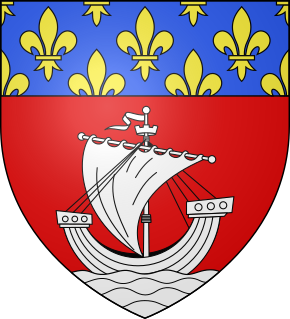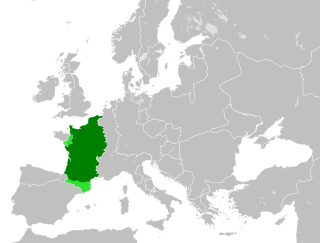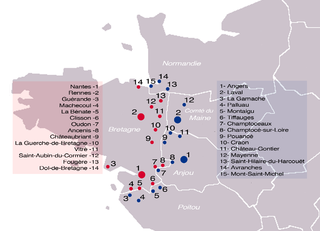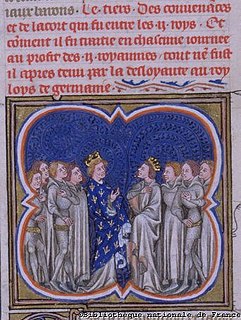Bérenger I (d. 882 or before) was the first known Count of Ivois. It is conjectured that Bérenger is the same person as Berengar I of Neustria, son of Gebhard, Count of Lahngau.
The Counts of Chiny were part of the nobility of Lotharingia that ruled from the 9th to the 14th century in what is now part of Belgium. The County of Chiny was created in the early 10th century out of the ancient county of Ivois. The county now forms part of the province of Luxembourg in present-day Belgium. The county of Chiny included the present-day cantons of Virton, Etalle, Florenville, Neufchâteau, Montmédy and Carignan, as well as the castles of Warcq on the Meuse, which was built in 971 by Otto, ancestor of the later Counts of Chiny. There is a close relationship between the Counts of Chiny and the Counts of Looz, the Counts of Verdun and the Bishops of Verdun.
Berengar I was a 9th-century nobleman of East Francia, a son of Gebhard, Count of Lahngau, and younger brother of Udo. He and his brother were created Margraves of Neustria by Charles the Bald in 861.
Gebhard was a mid-9th-century count in the Lahngau and the first documented ancestor of the dynasty later known as the Conradines. He was a "leading man of the [East] Franks" and a brother-in-law of Ernest, margrave of the Bavarian Nordgau. Gebhard may be a son of Odo I, Count of Orléans, if identical with Udo the Elder, count in the Lahngau from 821 to 826.
A charter dated 18 Sep 882 under which Hildebertus filius quondam Berengarii comitis [Hildebert, son of the late Count Berenger] donated property [Wavrense near the river] to the Saint-Vanne Abbey in Verdun is subscribed by Stephanus comes, Matfridus comes…[Earl Stephen, Earl Matfrid] both of whom appear to have been closely connected with the family of Adalardo Adalard the Seneschal who are described as propinquis [relatives] of Berengar in the Annales Bertiniani. Note that Adalhard’s grandsons were Stephen and Matfred. The necrology of Verdun Cathedral records the death of Berengarius comes qui dedit fratribus Superiacum [Count Bérenger, who donated Souvret].
Adalard, also known as Adalhard or Alard, and called the Seneschal, was a Frankish nobleman of the 9th century. He served as warden of the Norman march from 861 to 865, and was Lord Chancellor of France under Louis the Pious.
The Annales Bertiniani also record that Adalardo Yrmintrudis reginæ avunculo [Adalard the Seneschal] was a relative of the brothers Udo, Berengar and Waldo who were expelled from Germany in 865 and fought the Vikings in 865. This is compelling evidence that Bérenger I, Count of Ivois, is the same person as Berengar I of Neustria.
Udo was a 9th-century nobleman of East Francia, a son of Gebhard, Count of Lahngau, and older brother of Berengar I of Neustria. He and his brother were afforded their position in the March of Neustria both by kinship to Adalard the Seneschal and the favour of Charles the Bald.
The names of the wife or wives of Bérenger are not known. Bérenger is believed to have had at least two children:
- Hildebert, Count of Ivois
- Bérenger II (d. before 18 Sept 882)
Hildebert, was Count of Ivois, the successor to his father Bérenger I. Almost nothing is known about Hildebert other than a donation in his father's name to Saint-Vanne Abbey in Verdun in 882. The necrology of Verdun Cathedral records the death of Hildebertus comes [Count Hildebert] which is the only historical record of his being a count.
If the two Bérenger’s are indeed the same person, then this list of children would include Oda, wife of Arnulf the Bad, King of East Francia, disputed King of Italy and disputed Holy Roman Emperor, and mother of Louis the Child.
Ota, also called Oda, Uota, or Uta was Queen of the East Franks by marriage to Arnulf of Carinthia. She was the mother of Louis the Child. By birth she was probably a member of the Conradine Dynasty.

Arnulf of Carinthia was the duke of Carinthia who overthrew his uncle, Emperor Charles the Fat, became the Carolingian king of East Francia from 887, the disputed King of Italy from 894 and the disputed Holy Roman Emperor from February 22, 896 until his death at Regensburg, Bavaria.

Louis the Child, sometimes called Louis III or Louis IV, was the king of East Francia from 900 until his death in 911 and was the last ruler of Carolingian dynasty there. He succeeded his father, king Arnulf of Carinthia in 899, when he was only six. Louis also inherited the crown of Lotharingia with the death of his elder illegitimate half-brother Zwentibold in 900. During his reign the country was ravaged by Magyar raids.







